Vinyl fences are a popular choice for homeowners due to their durability and low maintenance. However, over time, these fences can fall victim to the unsightly presence of green algae, especially in damp or shaded areas.

The greenish tint not only diminishes the aesthetic appeal of the vinyl but also poses a risk of further deterioration. Fortunately, tackling this issue is not an arduous task. With a combination of effective cleaning techniques and some readily available household items, you can easily restore your vinyl fence to its original luster.
In this guide, we will explore practical and eco-friendly methods for how to remove green algae from vinyl fence, ensuring it not only remains visually pleasing but also stands the test of time against nature’s persistent attempts to mar its appearance. Say goodbye to green algae and hello to a pristine vinyl fence that enhances the curb appeal of your property.
Common Problem of Green Algae Growth on Vinyl Fences
The common problem of green algae growth on vinyl fences is not just a cosmetic issue; it can also compromise the integrity of the fence material over time. Green algae thrive in moist environments, often exacerbated by shady areas where sunlight is minimal, providing a perfect breeding ground on your fence surface.
Homeowners may notice the growth during or after the wet season, as algae spores can easily attach to the fence and multiply quickly given the right conditions. Barring aesthetic considerations, if left unchecked, algae can cause the vinyl to become brittle and more susceptible to cracks and degradation, which could ultimately affect the durability and lifespan of the fence.
Importance of Timely Removal of Green Algae

Removing green algae from vinyl fences is critical, not just to maintain the fence’s appearance, but to extend its lifespan. Algae accumulation can lead to material degradation, including staining, and may contribute to the breakdown of the vinyl, making it brittle and more prone to damage.
By addressing the algae issue promptly, homeowners can prevent long-term damage that could be costlier to repair down the line. Furthermore, a clean fence void of green algae is essential in preserving the fence’s aesthetic value and by extension, the overall curb appeal of the property. Regular maintenance, therefore, is key in ensuring that the fence continues to serve its purpose effectively while maintaining its visual appeal.
What Causes Green Algae to Grow on Vinyl Fences?
Green algae proliferation on vinyl fences is due to a confluence of factors, primarily the presence of moisture coupled with a lack of direct sunlight. Algae spores are omnipresent in the environment and become problematic when they land on surfaces that provide the ideal conditions for growth.
Vinyl, in particular, with its non-porous surface, can retain moisture, creating the perfect habitat for these spores to settle and reproduce.
Shaded areas of a property, which see little to no sunlight, are especially vulnerable as they remain damp longer and inhibit the natural drying process which would otherwise deter algae growth.
Additionally, organic debris such as leaves, grass clippings, and dirt can further feed the algae, exacerbating the issue and leading to more rapid colonization and spread on the surface of vinyl fences.
Characteristics and Appearance of Green Algae
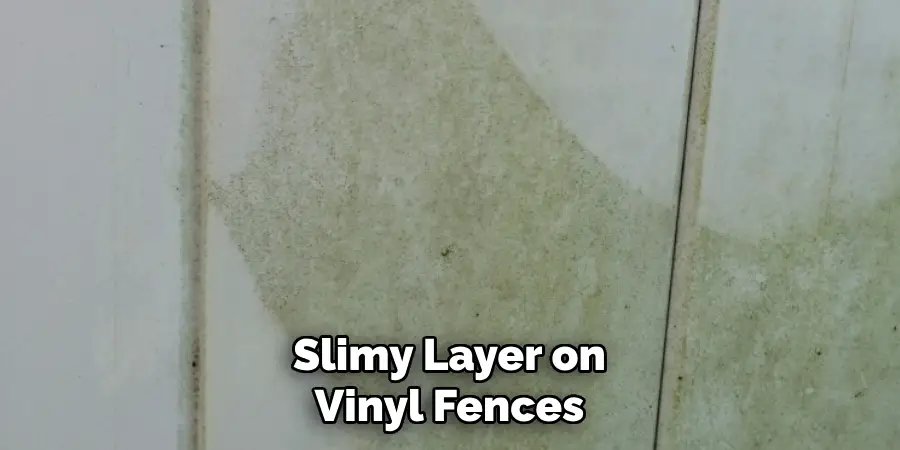
Green algae, known scientifically as Chlorophyta, is a diverse group of organisms that often presents itself as a soft, green, and sometimes slimy layer on vinyl fences. Its appearance can range from small patches to complete coverage, usually in dull, muted shades of green, though it can sometimes appear brighter depending on the specific species and environmental conditions.
These algae colonies start as specks barely visible to the naked eye and can grow to form a uniform film that clings tenaciously to the vinyl surface. Under the right conditions of warmth and moisture, algae can spread rapidly, covering significant portions of a fence and giving it a neglected and unappealing look.
Due to its photosynthetic nature, algae is equipped to thrive in environments with adequate light—though not necessarily direct sunlight—and adequate moisture, which unfortunately includes many outdoor settings where vinyl fences are typically found.
Preparing for Cleaning
Before addressing the green algae, it’s essential to prepare adequately to ensure a thorough and safe cleaning process. Start by protecting any nearby landscaping by covering plants and grass with plastic sheeting, as some of the cleaning solutions may be harmful to vegetation.
Wear protective gear, such as gloves and safety goggles, to shield yourself from splashes, especially if using chemical cleaners. Gather your cleaning supplies, which could include a bucket, water hose, soft-bristled brush, garden sprayer, and environmentally friendly cleaning solution or specialized vinyl fence cleaner.
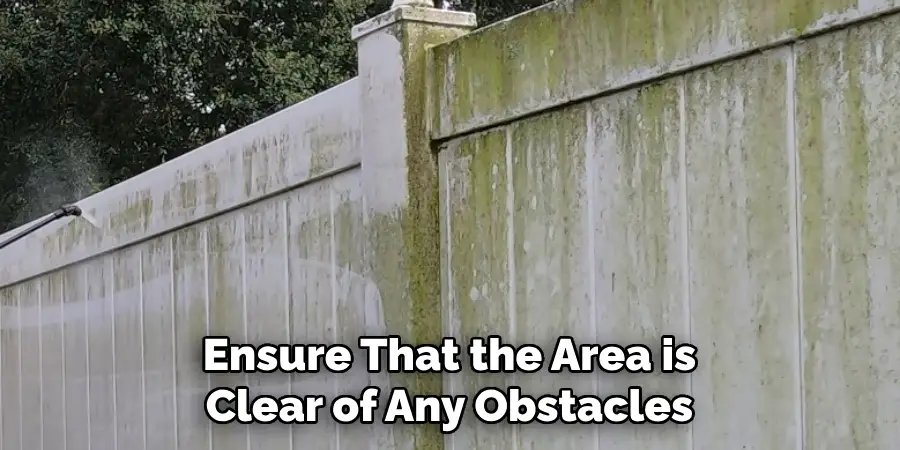
Ensure that the area is clear of any obstacles that might hinder access to the entire fence. It’s also advisable to choose a cloudy day or a cooler part of the day to prevent the cleaning solution from drying too quickly, which could hamper the algae removal process.
Safety Precautions and Protective Gear
When undertaking the task of cleaning green algae from your vinyl fence, safety must be your top priority. It is important to dress appropriately, wearing long sleeves and pants to avoid skin irritation that may be caused by the cleaning solutions.
Protective gear, including gloves, safety goggles, and a mask should be worn to prevent any accidental splashes of cleaning agents from coming into contact with your skin, eyes, or respiratory system.
If you choose to use a power washer, be sure to familiarize yourself with its operation to avoid injury and prevent damage to the fence. Always read labels and follow instructions on cleaning solutions to ensure they are used safely and effectively. By taking these safety measures, you can protect yourself and ensure a successful algae removal from your vinyl fencing.
10 Methods How to Remove Green Algae from Vinyl Fence
1. Soap and Water Solution:
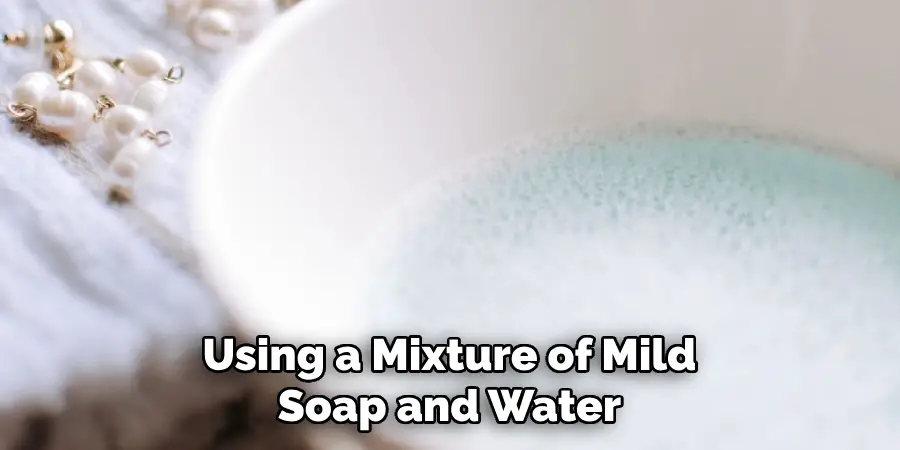
One of the simplest yet effective methods involves using a mixture of mild soap and water. Combine a few drops of dish soap with warm water and apply the solution to the algae-covered areas. Gently scrub the fence with a soft-bristle brush or sponge, then rinse thoroughly. This method is gentle on the vinyl while effectively breaking down algae.
Another option is to use a pressure washer. However, it is important to be cautious when using a pressure washer on vinyl fences as too much pressure can damage the material. Use the lowest setting possible and keep the nozzle at least 6 inches away from the fence to avoid any potential damage.
2. White Vinegar Spray:
White vinegar is a natural and powerful cleaning agent. Mix equal parts of white vinegar and water in a spray bottle. Spray the solution onto the algae-infested areas and let it sit for about 10-15 minutes. Scrub the vinyl fence with a brush, then rinse with water. Vinegar’s acidic properties help break down algae without posing harm to the environment. White vinegar can also be used to clean and remove stains from a variety of surfaces, including countertops, floors, and glass.
Vinegar can also be used as a natural fabric softener. Add 1/4 cup of white vinegar to your laundry’s rinse cycle for softer and fresher clothes. It helps to remove any residue left by detergent or hard water, making your clothes more comfortable to wear. Additionally, vinegar can be used as a natural deodorizer by placing a small bowl of it in your fridge or pantry to absorb any unwanted odors.
3. Baking Soda Paste:
Baking soda’s abrasive yet non-damaging nature makes it an excellent algae remover. Create a paste by mixing baking soda with water and apply it to the algae-covered sections. Allow the paste to sit for 15-20 minutes, then scrub the area with a brush. Rinse the fence thoroughly to remove any residue. Baking soda not only cleans but also acts as a mild abrasive to lift algae.
Baking soda is a versatile and affordable household product that can be used for various cleaning purposes. Its alkaline nature makes it effective in removing stubborn stains, dirt, and grime. In addition to being a great cleaning agent, baking soda also has antifungal and antibacterial properties, which make it an ideal solution for removing algae from surfaces such as fences.
4. Commercial Algae Cleaner:
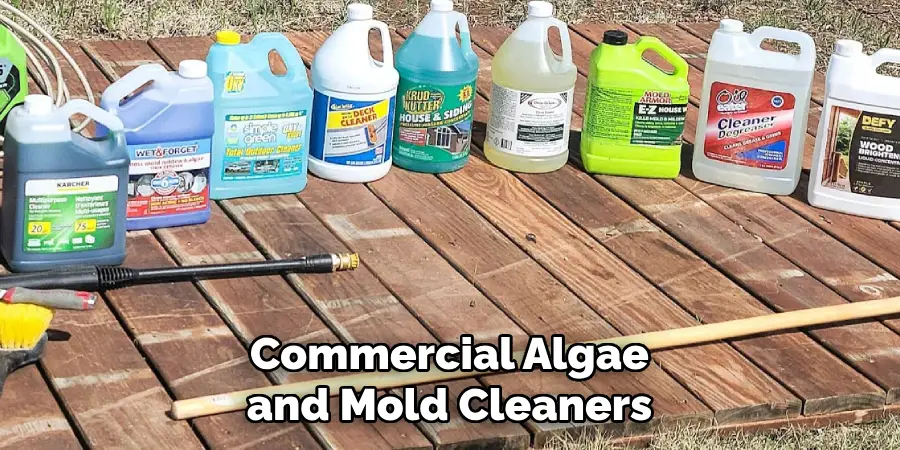
Numerous commercial algae and mold cleaners are specifically formulated for use on vinyl surfaces. These cleaners often come in spray or liquid form and contain ingredients designed to break down and eliminate algae. Follow the product’s instructions carefully, typically involving spraying, waiting, and rinsing, to achieve optimal results.
When purchasing a commercial algae cleaner, make sure to check the label for any warnings or precautions. Some cleaners may contain harsh chemicals that could be harmful to aquatic life or cause skin irritation. It’s important to use these products responsibly and follow all safety guidelines.
5. Oxygen Bleach Solution:
Oxygen bleach, unlike chlorine bleach, is non-toxic and safe for the environment. Mix the powder with water according to the product instructions, and apply the solution to the algae.
Allow it to sit for the recommended time, then scrub the vinyl fence and rinse thoroughly. Oxygen bleach is effective in removing algae without causing harm to the vinyl or surrounding vegetation. It also doesn’t leave any harmful residue, making it a safer option for cleaning outdoor surfaces.
Oxygen bleach solutions can also be used to clean other outdoor surfaces such as decks, patios, and driveways. It is strong enough to remove dirt and grime, but gentle enough to not damage the surface. Simply mix the solution with water in a bucket or spray bottle, and apply it to the surface. Let it sit for a few minutes before scrubbing and rinsing off with water.
6. Pressure Washing:
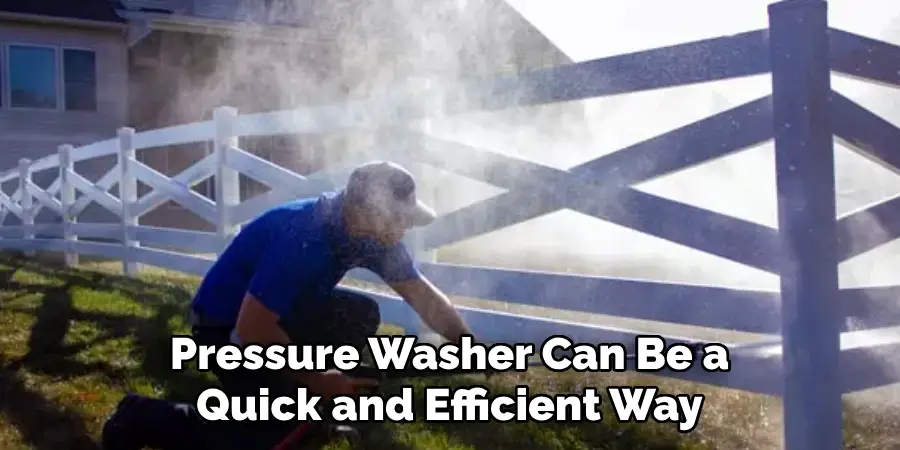
A pressure washer can be a quick and efficient way to remove algae from a vinyl fence. Use a low-pressure setting to avoid damaging the vinyl. Start at a distance and gradually move closer until you find the right balance between cleaning power and safety.
Exercise caution and follow safety guidelines when using a pressure washer. While pressure washing can be a great tool for cleaning, it’s important to use it properly and responsibly.
Pressure washers are also useful for removing dirt and grime from outdoor surfaces such as driveways, decks, and sidewalks.
They can save you time and effort compared to traditional methods of scrubbing or using a hose. However, it’s important to remember that pressure washers use a high-pressure spray that can be dangerous if not used correctly.
7. Hydrogen Peroxide Solution:
Hydrogen peroxide, a common household item, can also be used to combat green algae. Mix equal parts of hydrogen peroxide and water, then apply the solution to the algae-covered areas. Allow it to sit for about 15-20 minutes, scrub with a soft brush, and rinse thoroughly. Hydrogen peroxide is effective in breaking down algae and removing stains. It is also safe for the environment and will not harm plants or animals.
Apart from being an effective solution to combat green algae, hydrogen peroxide has many other uses. It can be used as a natural disinfectant for cleaning surfaces, killing bacteria and viruses without leaving any harmful residue. In fact, hydrogen peroxide is commonly used in hospitals and medical facilities for sterilization purposes.
8. Cornstarch Solution:
Create a thick paste by mixing cornstarch with water, and apply it to the algae on the vinyl fence. Allow the paste to dry completely before scrubbing it off with a brush. The abrasive nature of cornstarch, combined with its absorbent properties, helps remove algae and restore the fence’s appearance. Rinse the area thoroughly after scrubbing.
However, this method may not be suitable for painted or stained vinyl fences as it could potentially remove the finish.
To prevent algae growth on your vinyl fence, regularly clean it with a mild detergent and water solution. Avoid using harsh chemicals or abrasive cleaners as they can damage the fence’s surface.
Additionally, trimming overhanging branches and plants near the fence can help reduce exposure to moisture, which is a common cause of algae growth.
9. Preventive Measures:
To avoid recurring algae issues, consider implementing preventive measures. Trim nearby vegetation to increase sunlight exposure and reduce moisture on the fence.
Regularly clean the vinyl fence with mild soap and water to prevent algae buildup. Additionally, consider applying a vinyl protectant or sealant to create a barrier that discourages algae growth. Be sure to follow manufacturer instructions for any products used on the fence.
Another preventive measure is to improve drainage around the fence. Standing water can create a breeding ground for algae, so ensure that water flows away from the fence and doesn’t pool near it. This could involve grading the land or installing drainage systems.
10. Natural Sunlight and Rain:
Allow natural elements to work in your favor. Sunlight and rain can help naturally break down and wash away algae over time. While this method may take longer than others, it is a passive and eco-friendly approach that contributes to the overall cleanliness of your vinyl fence. Additionally, natural sunlight can help prevent mold and mildew from growing on your fence.
Rain is also an important factor in maintaining a clean vinyl fence. It helps to wash away dirt and debris that may accumulate on the surface of the fence. To maximize the effect of rain, you can also use a garden hose to lightly spray down your fence during or after a rainfall.
Regular Maintenance Checks
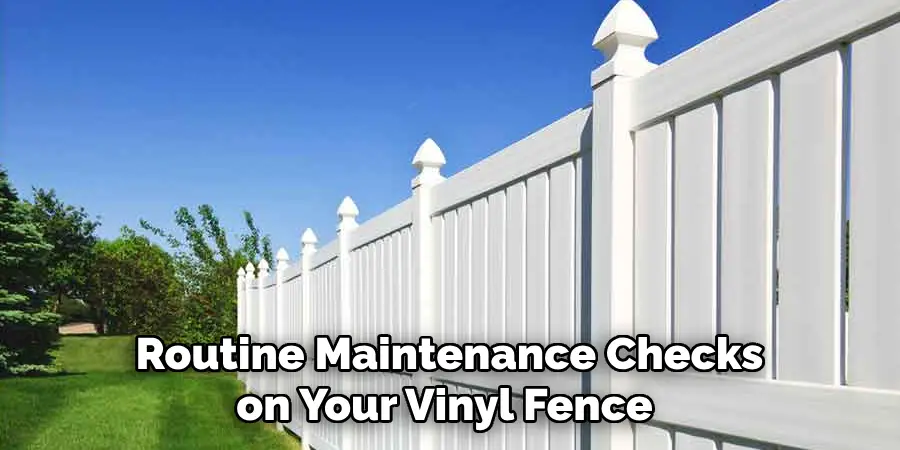
In addition to trimming vegetation and cleaning with soap and water, conducting routine maintenance checks on your vinyl fence can be instrumental in preventing algae growth. Look for any cracks or crevices where moisture might accumulate and seal any gaps promptly.
It is also wise to inspect the bottom of the fence where it meets the ground, as splash-back from rain can foster algae. Ensure proper clearance between the fence and the soil to minimize direct contact with moisture.
Furthermore, consider installing guttering or water diversion systems to direct rainwater away from the fence. By doing so, you reduce the chances of excessive water exposure that could lead to algae build-up. Remember, consistency in your prevention efforts will reward you with a cleaner, more durable vinyl fence over time.
Conclusion
In conclusion, effectively removing green algae from vinyl fences requires a systematic approach and the right tools. By understanding the causes of algae growth and employing appropriate cleaning solutions, homeowners can restore the beauty of their fences while prolonging their lifespan.
The process involves thorough preparation, including safety measures and the assessment of algae buildup. Utilizing environmentally friendly alternatives and adopting preventive measures can further enhance the effectiveness of algae removal and minimize regrowth.
Regular maintenance routines, such as periodic cleaning and inspection, are essential for sustaining a clean and algae-free vinyl fence over time.
By following these guidelines and staying proactive in maintenance efforts, homeowners can enjoy a pristine outdoor space and preserve the aesthetic appeal and structural integrity of their vinyl fences for years to come. Thanks for reading, and we hope this has given you some inspiration on how to remove green algae from vinyl fence!
About
Outdoor Fixes is a distinguished figure in the world of Diy design, with a decade of expertise creating innovative and sustainable Diy solutions.
His professional focus lies in merging traditional craftsmanship with modern manufacturing techniques,
fostering designs that are both practical and environmentally conscious. As the author of diy,
outdoorfixes delves into the art and science of outdoorfixes-making, inspiring artisans and industry professionals alike.
Education RMIT University
(Melbourne, Australia) Associate Degree in Design (Outdoor Fixes) Focus on sustainable design, industry-driven projects,
and practical craftsmanship. Gained hands-on experience with traditional and digital manufacturing tools, such as CAD and CNC software.
Nottingham Trent University
(United Kingdom) Bachelor’s in outdoorfixes.com and Product Design (Honors) Specialized in product design with a focus on blending creativity with production
techniques. Participated in industry projects, working with companies like John Lewis and Vitsoe to gain real-world insights.
Publications and Impact
In diy, Outdoor Fixes his insights on indoor design processes, materials, and strategies for efficient production.
His writing bridges the gap between artisan knowledge and modern industry needs, making it a must-read for both budding designers and seasoned professionals.

